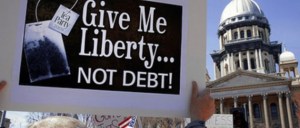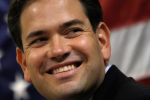In December, Gallup reported that the tea party was more unpopular than ever.
Videos by Rare
The same month, Gallup reported that a strong majority of Americans feared big government more than ever.
Wait, wasn’t the purpose of the tea party to fight big government?
Today, tea party sentiment is still very popular. In April, we learned people were more worried about creeping government than just about anything else, including terrorism. In early 2013, a Gallup survey revealed that the deficit, debt and dissatisfaction with government ranked as top concerns. In October, Pew Research Center data showed Americans’ distrust of government was at an all-time high.
The tea party never lost public support for its goals. It lost itself.
In the beginning, fear of government growth and spending wasn’t just the top concern for the tea party—it was the only concern. As Time reported in 2010 many different groups had “united under the banners of smaller government, fiscal responsibility and free markets.”
Nor did the movement begin as just an obsession with President Obama. CNN reported in 2010, “many activists cite a few events during the end of President Bush’s term and the beginning of President Obama’s, as the final straws: the bailout of banks, the bailout of two of the Big Three automakers and the economic stimulus plan.”
The tea party’s original bipartisan critique of big government showed that different groups could come together for the singular purpose of reining in Washington, DC. Polls at the time showed that even though a majority of Americans didn’t identify as Tea Partiers, most shared their goals.

The tea party got distracted when it lost its singular focus on fiscal responsibility—broadening its scope to also focus on religion, and abortion, and gay marriage, and immigration, and the 2nd Amendment, and unfortunate diversions like Birther conspiracies and clumsy comments from some about “legitimate rape.”
The point is not that some of these conservative issues are not worthy of advocating for, or in the case of some of these examples, against. I’m Christian, pro-life and pro-gun—and each of these positions already has well-organized, pre-existing advocacy movements. Embracing multiple issues as part of the tea party agenda went far beyond the singular issue of government largesse that had originally united the movement and so many Americans.
Things got muddy.
The tea party lost its focus and in trying to do too much it ceased being a more ideologically substantive movement, or at least a broadly popular one. Americans always liked the tea party’s original idea of smaller government, but soured on the brand later precisely because there became so many different perceptions about what the movement stood for, many of them negative.
Tea party diversity was always key. In 2010, polls showed that almost half of the tea party was more socially conservative, identifying with Sarah Palin and the other half leaned libertarian, identifying with Ron Paul. The tea party also included a good number of independents, or as Politico reported of the historic April 15 protests of 2010, “In general, those who turned out for the April 15 event tended to be less culturally conservative than national Republicans.”
The tea party should be a home for Christian, pro-life, traditional marriage supporting, border security advocates. But it should also be a home for anyone who believes in fighting big government, even if they disagree with some conservatives on these issues.
In 2010, the New York Times commented on how the tea party largely avoided social issues. Gallup noted that although the movement was right-of-center, the average tea partier was fairly mainstream demographically.
Today, as more Americans shy away from the “tea party” as a brand, more people than ever are embracing the libertarian label, including some of the independents that were once so sympathetic to the tea party. FreedomWorks even notes that the Republican Party is becoming more libertarian because America is.
The overlap between the tea party and libertarians has been evident since the beginning, or as Cato’s David Kirby and Emily McClintock Ekins noted in their 2012 policy analysis, “The Libertarian Roots of the Tea Party:” “Understanding the tea party’s strong libertarian roots helps explain how the tea party movement has become a functionally libertarian influence on the Republican Party.”
McClintock and Ekins’ report concluded:
Libertarians led the way for the tea party. Starting in early 2008 through early 2009, we find that libertarians were more than twice as “angry” with the Republican Party, more pessimistic about the economy and deficit since 2001, and more frustrated that people like them cannot affect government than were conservatives. Libertarians, including young people who supported Ron Paul’s 2008 presidential campaign, provided much of the early energy for the tea party and spread the word through social media.
The members of Congress most likely to lead a shift toward smaller government and less spending—Senators Rand Paul, Mike Lee and Ted Cruz or Representatives like Justin Amash and Thomas Massie—would’ve never been elected if not for the tea party. Each of these leaders were also prominent “liberty movement” candidates.

Today, it is these tea party and libertarian Republicans who represent the only conservative substance the GOP has. The media often uses the terms “tea party” and “libertarian” interchangeably when discussing certain members or wings of the Republican Party precisely because both labels accurately represent the temperament and philosophy of the grassroots right.
Many libertarians do not readily identify with the tea party today for the same reason a majority of Americans don’t. The problem is branding, not the message, or at least most libertarians never had a problem with the tea party’s original message. Indeed, libertarianism was always a major part of that message.
Whether a mass movement to reform Washington ends up being called the tea party, libertarian or something else, the goal of shrinking government will always be more important than the name. Liberals and establishment Republicans who now delight in bashing the tea party, seeing it as “dead” or “over” do not represent anything America really wants either.
The tea party isn’t going anywhere because Americans’ desire for less government isn’t going anywhere. And whatever you call it, the political conditions are arguably better today than they were five years ago to build an American majority that can end big government for good.



